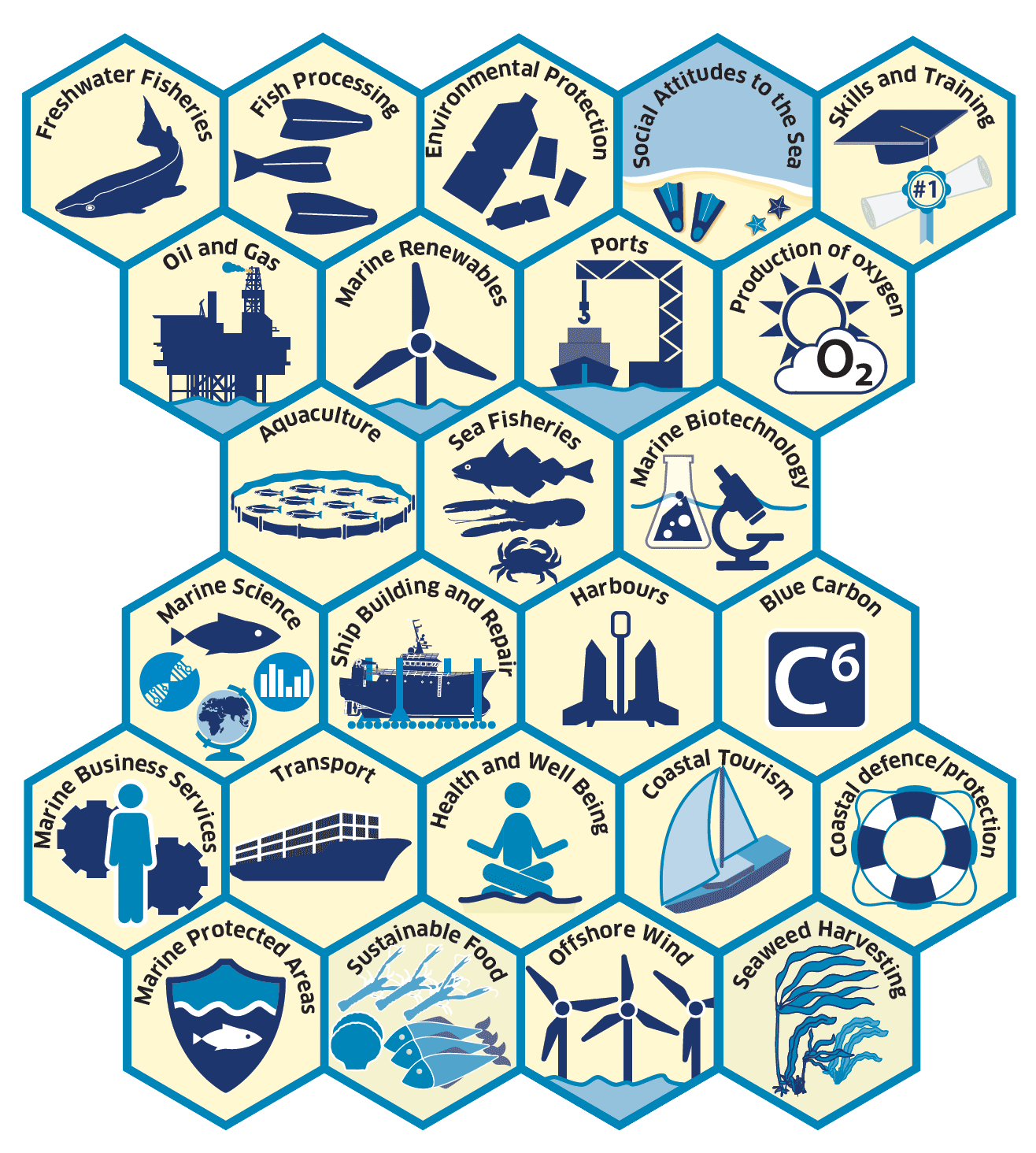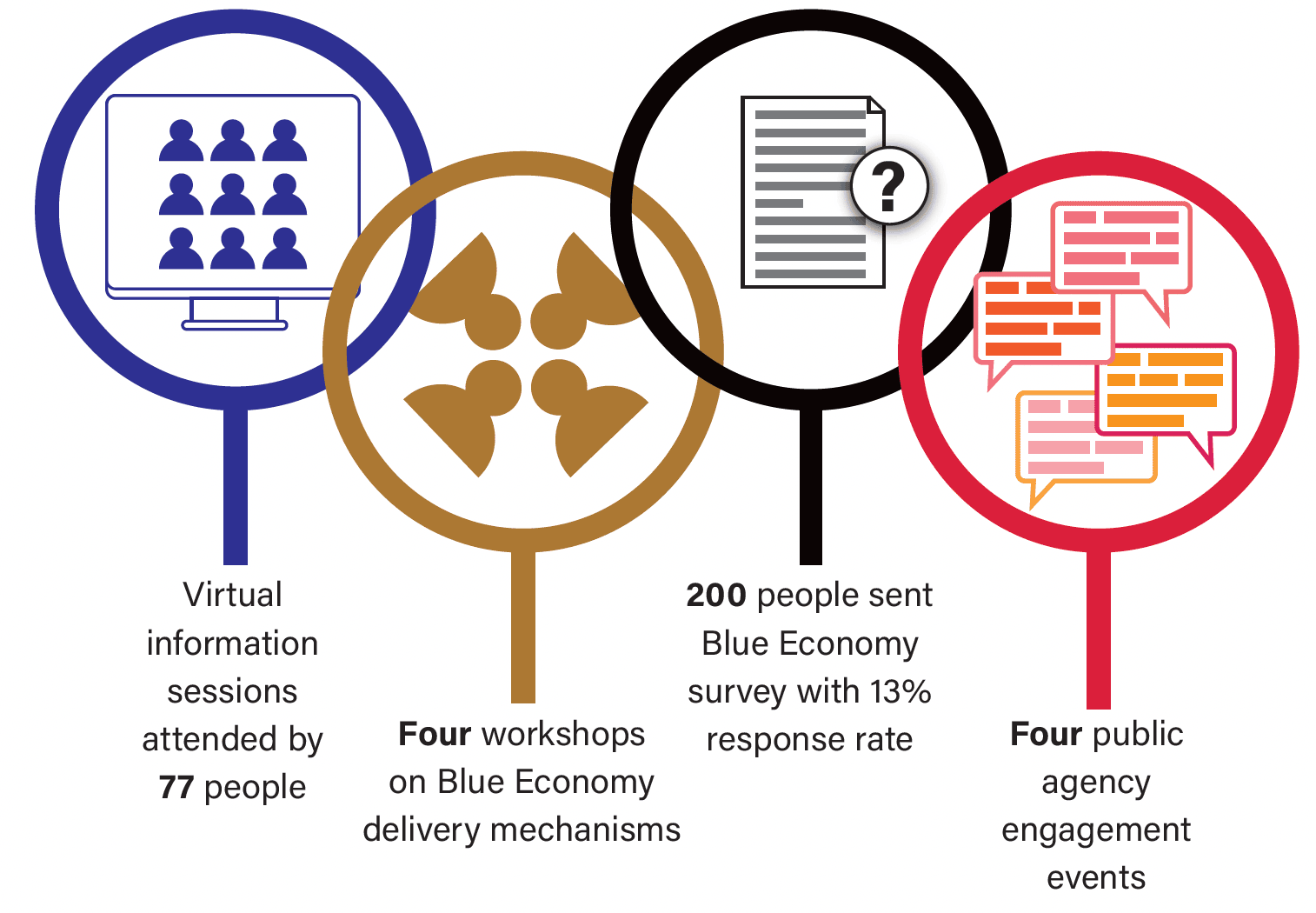Delivering Scotland's Blue Economy approach
Sets out the first phase of delivery towards our Blue Economy Vision (published March 2022). It provides a clear picture of where we are now in relation to the six Blue Economy outcomes and sets out our next steps in delivering a collaborative approach in Scotland.
1. Introduction
Blue Economy Vision Statement
By 2045, Scotland's shared stewardship of our marine environment supports ecosystem health, improved livelihoods, economic prosperity, social inclusion and wellbeing.
The Blue Economy Vision was published by the Scottish Government in March 2022. The Vision sets out the need for transformative change to create fairer, more prosperous, nature-positive marine sectors and communities. It defines our long-term ambition for shared stewardship of Scotland's marine environment, which puts nature on a more equal footing with social and economic considerations. At its core, our vision recognises that economic prosperity and well-being are embedded within nature, and in order to harness blue opportunities, we must transform our economy and society to thrive within the planet's sustainable limits. By delivering the Blue Economy Vision, we will ensure that our marine assets support Scotland's wider goal to become a wellbeing economy as set out in the National Strategy for Economic Transformation.
We have defined Scotland's Blue Economy as encompassing:
- all sectoral and cross-sectoral economic activities on, or related to, the ocean, coasts and interlinked freshwater environments
- the physical and ecological components of the marine environment
- all people connected to the sea
- relevant legislation, policies, programmes and international commitments
- scientific research that enables evidence-informed policy and evaluates success

Graphic text below:
- Freshwater Fisheries
- Fish Processing
- Environmental Protection
- Social Attitudes to the Sea
- Skills and Training
- Oil and Gas
- Marine Renewables
- Ports
- Production of oxygen
- Aquaculture
- Sea Fisheries
- Marine Biotechnology
- Marine Science
- Ship Building and Repair
- Harbours
- Blue Carbon
- Marine Business Services
- Transport
- Health and Well Being
- Coastal Tourism
- Coastal defence/protection
- Marine Protected Areas
- Sustainable Food
- Offshore Wind
- Seaweed Harvesting
Figure 1 sets out the aspects which make up Scotland's Blue Economy.
Alongside the Vision, we presented six interlinked outcomes to provide a focus for the efforts of the Scottish Government and our partners as we collectively work towards delivering shared stewardship of our Blue Economy (Box 1). Two of the Blue Economy outcomes describe our ambitions for the environment, focussing on nature, climate change and sustainable use of resources. A further two outcomes describe our aspirations for sectors that operate within the Blue Economy, with a focus on innovation, investment in Scottish supply chains, sustainability and international trade. The final two outcomes describe our ambitions for the people and communities of Scotland, focussing on equality, civic engagement and skills and lifelong learning. A successful Blue Economy approach will mean pursuing all six outcomes in tandem, and, ultimately, a transition away from conventional thinking that stipulates we must always trade off economic production against environmental protection, to instead recognising that we can achieve both. There will be difficult choices in delivering this transformation. Science and evidence must underpin decision-making about what activities are prioritised where and when, and we must consider co-dependencies, interactions synergies between different interests and any cumulative impacts. It will be important to ensure sufficient time and support to those within the Blue Economy as part of this transformation.
The Blue Economy Vision and outcomes represent a long-term strategy document that serves as an overall framework for policies and actions. In order to achieve the Vision and outcomes by 2045, we recognise that we will need a combination of immediate, priority actions, and the development of longer-term decision-making tools, guidance and transformation plans. We need an approach that allows us to respond to new challenges and opportunities as they emerge. We also need to be able to measure our progress and evaluate our success to ensure that the right changes are happening. This means that we must take an adaptive approach, with multi-phased delivery of the Blue Economy Vision required between now and 2045.
Box 1 : the six Blue Economy outcomes
- EN1 Natural Capital Outcome: Scotland's marine ecosystems are healthy and functioning, with nature protected and activities managed using an ecosystem-based approach to ensure negative impacts on marine ecosystems are minimised and, where possible, reversed.
- EN2 Climate Change Outcome: Scotland's Blue Economy is resilient to climate change, contributing to climate mitigation and adaptation, with marine sectors decarbonised, resource efficient and supporting Scotland's Net Zero and Nature Positive commitments.
- EC1 Economic & Trade Outcome: Established and emerging marine sectors are innovative, entrepreneurial, productive and internationally competitive.
- EC2 Food Security, Nutrition & Health Outcome: Scotland is a global leader in healthy, quality, sustainably harvested and farmed Blue Foods, for our own population and beyond.
- SO1 Social Inclusion & Equalities Outcome: Thriving, resilient, regenerated, healthy communities have more equal access to the benefits that ocean resources provide.
- SO2 Ocean Literacy Outcome: Scotland is an ocean literate and aware nation.
A full description of the Blue Economy outcomes is available in the Vision.
This document sets out the first phase of delivery towards our Blue Economy Vision, as well as the commitment and timeline for subsequent phases. The purpose of this phase is to provide a clear picture of where we are now in relation to the Blue Economy outcomes.
An assessment of our current position is a vital first step if we are to identify where new or different actions are needed to deliver transformative change. We have undertaken a status review of Scotland's Blue Economy against the six outcomes, drawing together a range of existing data across the 'four capitals' (human, social, economic and natural assets) recognised in Scotland's National Strategy for Economic Transformation. This includes data from several sources including the Scottish Marine Assessment, Scotland's Marine Economic Statistics, the National Performance Framework, Scottish Sea Fisheries Statistics and the Annual Population Survey. We have also taken stock of existing actions and commitments across the government and wider public sector landscape to identify how they contribute towards the Blue Economy outcomes, and the synergies between them.
Using the initial assessment, we have identified where we have areas already targeted by policy initiatives. We have evaluated the types of tools, interventions and levers that will be required to enable the achievement of the Blue Economy outcomes, and where ownership of these is likely to sit across the public sector, private sector, voluntary organisations and communities.
Since the publication of the Blue Economy Vision, we have undertaken our first round of stakeholder engagements, including roundtable events with public agencies, virtual information sessions and a stakeholder survey (Figure 2). We have highlighted throughout this document where feedback from these engagements has been incorporated. Finally, we have used the analysis from our phase one activities to define a pathway and timeline for subsequent phases of our Blue Economy approach.

Graphic text below:
Virtual information sessions attended by 77 people
Four workshops on Blue Economy delivery mechanisms
200 people sent Blue Economy survey with 13% response rate
Four public agency engagement events
Contact
Email: sally.rouse@gov.scot
There is a problem
Thanks for your feedback